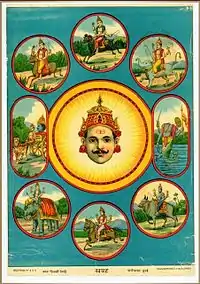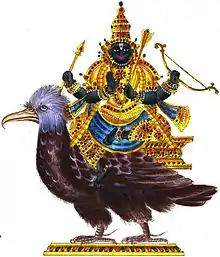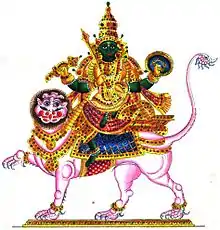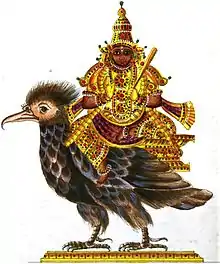Navagraha
Navagraha are nine heavenly bodies (as well as deities) that influence human life on Earth in Hinduism and Hindu astrology. The term is derived from nava (Sanskrit: नव "nine") and graha (Sanskrit: ग्रह "planet, seizing, laying hold of, holding"). Note that Bhudevi (Earth), Uranus and Neptune are not considered. [2]

Navagraha, a Raja Ravi Varma painting (sun at the center)
Planets, celestial bodies and lunar nodes
| No. | Image | Name (Vedic) | Western equivalent |
|---|---|---|---|
| 1. |  |
Surya, Ravi | Sun |
| 2. |  |
Chandra, Soma | Moon |
| 3. |  |
Budha | Mercury |
| 4. |  |
Shukra, Shukracharya | Venus |
| 5. |  |
Mangala, Angaraka | Mars |
| 6. |  |
Bṛhaspati, Guru | Jupiter |
| 7. |  |
Shani, Shaneeswara | Saturn |
| 8. |  |
Rahu | North node of the Moon |
| 9. |  |
Ketu | South node of the Moon |
Carnatic Music
Muthuswami Dikshitar, a Carnatic music composer from southern India composed the Navagraha Kritis in praise of the nine grahas.[3] Each song is a prayer to one of the nine planets. The sahitya (lyrics) of the songs reflect a profound knowledge of the mantra and jyotisha sastras.
See also
Notes
| Wikimedia Commons has media related to Navagraha. |
- Sanskrit-English Dictionary by Monier-Williams, 1899
- "Dikshitar: Navagraha". www.medieval.org. Retrieved 2020-06-12.
This article is issued from Wikipedia. The text is licensed under Creative Commons - Attribution - Sharealike. Additional terms may apply for the media files.

